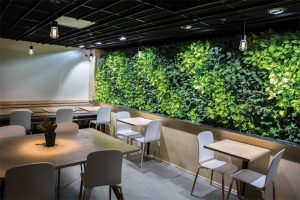
Photo courtesy LiveWall and Acheff Images
In examining the relationship between what the researchers called “greenness” and test performance after adjusting for levels of urbanization, income levels, and gender, researchers found spring data particularly compelling. Spring is when children take the Massachusetts Comprehensive Assessment System (MCAS). March outcomes revealed a highly significant association between school performance in both Math and English and surrounding greenness, particularly as the buffer zone widened. Results from July and August suggest children with higher levels of exposure to greenness during the rest of the year show better academic performance.
Why green walls
Also known as living walls, green walls are integrated structural and horticultural systems attached to existing walls to transform them into vertical gardens. Green walls are a good way to achieve the benefits of biophilic design in commercial buildings. There are several reasons why building owners and facility managers find green walls to be a practical and attractive solution for bringing the outdoors indoors.
Living walls may be mounted on nearly any type of interior wall from reinforced concrete to wood framing. Specifiers may need to indicate required spacing, which varies for different types of green wall systems, as well as the type of fastener appropriate for the wall on which a vertical garden is to be mounted. For example, 6 to 44-mm (¼ x 1 ¾-in.) hex washer head screw anchors are specified for brick or poured walls and 4 to 25-mm (0.16 to 1-in.) ballistic head fasteners are appropriate for steel/aluminum studs.
Living wall costs can vary greatly, depending on the size and shape, location and accessibility, plant selection, and local labor rates. In this author’s experience, most commercially installed green walls can cost between $90 and $150 per square foot.
With an eye toward the cost of commercial space per square foot, it makes business sense to place interior plantscapes on walls and thereby conserve valuable floor space for other uses. As most living walls have integrated irrigation, they cost less to care for than individual potted plants and herbs requiring regular hand-watering. Living walls also provide a larger, more prominent, and engaging display of plants than individual potted plants. Plantings at or above eye-level are more noticeable and attract attention from a distance.
Green walls can also be an attractive, organic alternative to a variety of traditional two-dimensional architectural treatments. Enclosing equipment or utilities such as HVAC units with living walls converts the view of unsightly mechanicals into beautiful points of interest.
| REFERENCES |
| 1. Biophilia by Edward O. Wilson, (Harvard University Press, 1984).
2. The Biophilia Hypothesis, Stephen R. Kellert and Edward O. Wilson, ed. (Island Press, 1993). 3. Biophilic Design: The Theory, Science and Practice of Bringing Buildings to Life, Stephen R. Kellert, Judith H. Heerwagen and Martin L. Mador, ed. (John Wiley & Sons, 2008). 4. Janet Dunn’s article, “Biophilic design: How architecture can contribute to a healthier, less-stressful life,” for the Architect (February 21, 2018). 5. “Therapeutic Influences of Plants in Hospital Rooms on Surgical Recovery” by Seong-Hyun Park and Richard H. Mattson (HortScience, 2009). 6. “14 Patterns of Biophilic Design: Improving Health and Well-Being in the Built Environment” by William Browning, Catherine Ryan, and Joseph Clancy, (Terrapin Bright Green, LLC, 2014). |
Ensuring green wall success
Green industry experts, living wall manufacturers, architects, interior designers, and building owners agree the following factors must be addressed for a successful installation.
Goals
Defining goals at the start of the planning process is essential. Goals determine the size and placement of a living wall.
Is the green wall primarily intended for building occupants or visitors? Are specific green wall benefits a priority? For example, if a green wall is intended for the occupants of a commercial building to gain productivity benefits, it will have to be highly visible to the people who work in the building.
Location
The goals for the green wall have a major influence on where it will be installed. However, other factors are also important. This includes plumbing for watering the plants, electricity for lights and irrigation timers, and floor drainage.
System selection
One must select a system that achieves the defined goals and will have predictable maintenance costs. The two important questions to ask are:
- how long are the plants expected to perform in the structure before they need replacement; and
- how simple is plant replacement?
Since tropical plants typical of indoor installations have large root structures, a system with a larger planter size will require less frequent replacements. Plant orientation within planters is as important as size. Green walls should support plants as nature intended with roots growing down and stems and leaves growing up. Additionally, it is advisable to ask potential suppliers about how water is delivered and drained from the plants, the management of soil fertility, and expected maintenance costs.
Design
Lighting is probably one of the most overlooked aspects of green wall design. The light sources commonly used for human comfort in commercial interiors lack sufficient intensity and fall outside of the spectrum required to support healthy plants. It is best to involve the green wall system supplier in the selection of the actual light bulb or source to provide the right spectrum for plants. When it comes to fixtures, ceiling-mounted track lighting is the most flexible method of illuminating a green wall, as it allows for adjusting the angle and spacing to evenly light the surface.
In addition to light spectrum, light intensity (a measure of light energy hitting the plant surface) is a critical factor for plant health. For most tropical foliage plantings, 2153 to 4306 lux (200 to 400 fc) of light energy is sufficient to provide the required nutrition.




